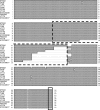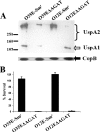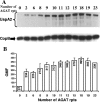A conserved tetranucleotide repeat is necessary for wild-type expression of the Moraxella catarrhalis UspA2 protein
- PMID: 16963572
- PMCID: PMC1636323
- DOI: 10.1128/JB.01204-06
A conserved tetranucleotide repeat is necessary for wild-type expression of the Moraxella catarrhalis UspA2 protein
Abstract
The UspA2 protein has been shown to be directly involved in the serum-resistant phenotype of Moraxella catarrhalis. The predicted 5'-untranslated regions (UTR) of the uspA2 genes in several different M. catarrhalis strains were shown to contain various numbers (i.e., 6 to 23) of a heteropolymeric tetranucleotide (AGAT) repeat. Deletion of the AGAT repeats from the uspA2 genes in the serum-resistant M. catarrhalis strains O35E and O12E resulted in a drastic reduction in UspA2 protein expression and serum resistance. PCR and transformation were used to construct a series of M. catarrhalis O12E strains that differed only in the number of AGAT repeats in their uspA2 genes. Expression of UspA2 was maximal in the presence of 18 AGAT repeats, although serum resistance attained wild-type levels in the presence of as few as nine AGAT repeats. Increased UspA2 expression was correlated with both increased binding of vitronectin and decreased binding of polymerized C9. Real-time reverse transcription-PCR analysis showed that changes in the number of AGAT repeats affected the levels of uspA2 mRNA, with 15 to 18 AGAT repeats yielding maximal levels. Primer extension analysis indicated that these AGAT repeats were contained in the 5'-UTR of the uspA2 gene. The mRNA transcribed from a uspA2 gene containing 18 AGAT repeats was found to have a longer half-life than that transcribed from a uspA2 gene lacking AGAT repeats. These data confirm that the presence of the AGAT repeats in the 5'-UTR of the uspA2 gene is necessary for both normal expression of the UspA2 protein and serum resistance.
Figures










Similar articles
-
The UspA2 protein of Moraxella catarrhalis is directly involved in the expression of serum resistance.Infect Immun. 2005 Apr;73(4):2400-10. doi: 10.1128/IAI.73.4.2400-2410.2005. Infect Immun. 2005. PMID: 15784586 Free PMC article.
-
Binding of vitronectin by the Moraxella catarrhalis UspA2 protein interferes with late stages of the complement cascade.Infect Immun. 2006 Mar;74(3):1597-611. doi: 10.1128/IAI.74.3.1597-1611.2006. Infect Immun. 2006. PMID: 16495531 Free PMC article.
-
Total genome polymorphism and low frequency of intra-genomic variation in the uspA1 and uspA2 genes of Moraxella catarrhalis in otitis prone and non-prone children up to 2 years of age. Consequences for vaccine design?Vaccine. 2003 Mar 7;21(11-12):1118-24. doi: 10.1016/s0264-410x(02)00522-4. Vaccine. 2003. PMID: 12559789
-
Impact of sequence diversity in the Moraxella catarrhalis UspA2/UspA2H head domain on vitronectin binding and antigenic variation.Microbes Infect. 2013 May;15(5):375-87. doi: 10.1016/j.micinf.2013.02.004. Epub 2013 Mar 6. Microbes Infect. 2013. PMID: 23474333
-
The emerging pathogen Moraxella catarrhalis interacts with complement inhibitor C4b binding protein through ubiquitous surface proteins A1 and A2.J Immunol. 2004 Oct 1;173(7):4598-606. doi: 10.4049/jimmunol.173.7.4598. J Immunol. 2004. PMID: 15383594
Cited by
-
Identification of a bacteriocin and its cognate immunity factor expressed by Moraxella catarrhalis.BMC Microbiol. 2009 Sep 25;9:207. doi: 10.1186/1471-2180-9-207. BMC Microbiol. 2009. PMID: 19781080 Free PMC article.
-
Identification of an outer membrane lipoprotein involved in nasopharyngeal colonization by Moraxella catarrhalis in an animal model.Infect Immun. 2014 Jun;82(6):2287-99. doi: 10.1128/IAI.01745-14. Epub 2014 Mar 18. Infect Immun. 2014. PMID: 24643539 Free PMC article.
-
A Moraxella catarrhalis two-component signal transduction system necessary for growth in liquid media affects production of two lysozyme inhibitors.Infect Immun. 2015 Jan;83(1):146-60. doi: 10.1128/IAI.02486-14. Epub 2014 Oct 13. Infect Immun. 2015. PMID: 25312959 Free PMC article.
-
Moraxella catarrhalis expresses an unusual Hfq protein.Infect Immun. 2008 Jun;76(6):2520-30. doi: 10.1128/IAI.01652-07. Epub 2008 Mar 24. Infect Immun. 2008. PMID: 18362134 Free PMC article.
-
Genotypic Characterization of Infectious Spleen and Kidney Necrosis Virus (ISKNV) in Southeast Asian Aquaculture.Transbound Emerg Dis. 2023 Mar 21;2023:6643006. doi: 10.1155/2023/6643006. eCollection 2023. Transbound Emerg Dis. 2023. PMID: 40303689 Free PMC article.
References
Publication types
MeSH terms
Substances
Grants and funding
LinkOut - more resources
Full Text Sources
Other Literature Sources
Molecular Biology Databases
Research Materials
Miscellaneous

